Refraction & Vergence
1/20
Earn XP
Description and Tags
Use the concept of vergence at plane and curved surfaces in calculations for image position, magnitude, orientation and use and understand the concept of refraction in optical applications
Name | Mastery | Learn | Test | Matching | Spaced |
|---|
No study sessions yet.
21 Terms
Refraction and Refractive Index
Refraction is the change in direction of a light wave due to a change in its velocity
Imagine a glass of water with a pencil inside (picture): The pencil seems to bend at the water surface. Reason for this effect: air and water have different refractive indices and thus, cause the velocity of light to change
Meaning of refractive index (n): It is the ability of a medium to slow light down in a transparent material.
n = speed of light in a vacuum / speed of light in medium
n in air : nair = 3 × 108 m/s / 3 × 108 m/s = 1
Refractive index (n) is the ability of a medium to ___________ down in a transparent material.
Slow light
Refractive Index ‘n’ (Also Abbreviated as RI)
How is “n” determined?
White light consists of many different wavelengths, each of which is slowed down at a different rate (affecting n)
To overcome this issue: “n” is given for specified spectral lines in the ISO 7944:
UK: 587.562 nm (Helium ‘d’ line)
France & Germany: 546.073 nm (Mercury ‘e’ line)
Because these correspond closely to the wavelength the human eye is most sensitive to in daylight (photopic) conditions 555nm
___________ consists of many different wavelengths, each of which is slowed down at a different rate (affecting n).
White light
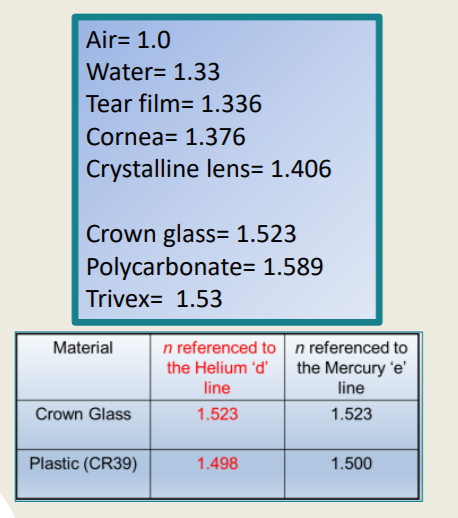
Refractive Indices to Remember
Typical refractive indices (n) used in Optometry are:
Air =1.0
Water = 1.33
Tear Film = 1.336
Cornea = 1.376
Crystalline Lens = 1.406
Crown Glass = 1.523
Polycarbonate = 1.589
Trivex = 1.53
Nevertheless, be careful when reading manufacturer’s technical data to decide on appropriate lens materials.
For plastic (CR39), ‘n’ referenced to the Helium ‘d’ line is ________ and ‘n’ referenced to the Mercury ‘e’ line is ________.
1.498; 1.500
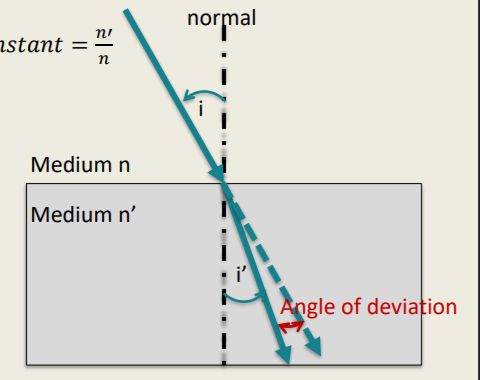
Laws of Refraction
The incident (i) and refracted (i’) light rays lie in one plane which is normal to the refracting surface at the point of refraction
The ratio of the sine of the angle of incidence (i) to the sine of the angle of refraction (i’) is a constant.
This is called Snell’s Law (Snell 1580-1626) : sin 𝑖 / sin 𝑖′ = 𝑐𝑜𝑛𝑠𝑡𝑎𝑛𝑡 = 𝑛′/ n
A __________ is the ratio of the sine of the angle of incidence (i) to the sine of the angle of refraction (i’).
Constant
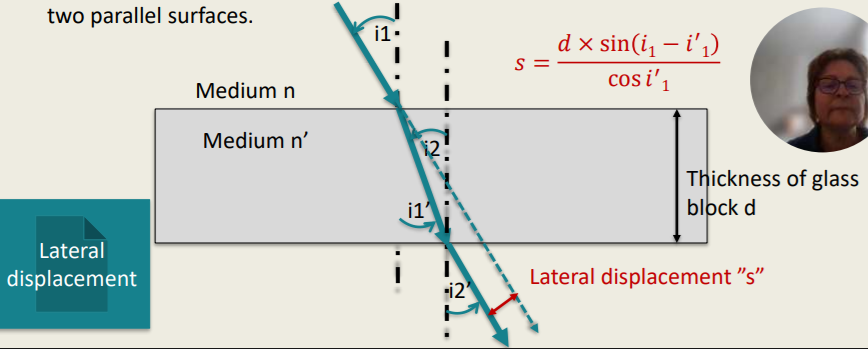
Refraction on Plane Surfaces - Glass Block
Laws of Refraction:
Incident, refracted light ray and normal to the surface are in one plane
Snell’s law: 𝒏 × 𝐬𝐢𝐧 𝒊 = 𝒏′ × 𝐬𝐢𝐧 𝒊′
The laws of refraction apply on each surface. Thus, in case of two surfaces (e.g. lenses, glass block), they apply twice.
The light ray emerging from the block does not change direction, but it “jumps”. This jump is called lateral displacement (s) and, it happens when light is refracted through two parallel surfaces.
The laws of refraction apply on each surface. True or False?
True
Refraction on Plane Surfaces - ‘Total Internal Reflection’
When a light ray enters a transparent medium (e.g. water or glass) at a certain angle – the critical angle “ic” – total internal reflection occurs.
Application of total internal reflection: fibre optics (cables) , Sclerotic Scatter (Slit Lamp technique)
Total reflection depends upon two aspects:
Refractive index difference (n’-n) between both media; nfibre > nenvironment
Angle of incidence i at the surface; i > ic
When a light ray enters a transparent medium (e.g. water or glass) at a certain angle – the _________ “ic” – total internal reflection occurs.
Critical Angle
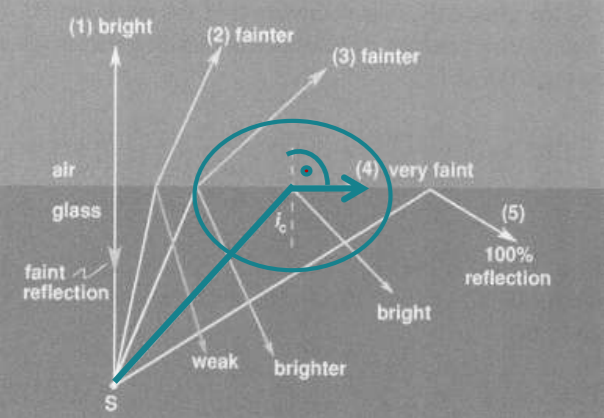
Refraction on Plane Surfaces - Total Internal Reflection - Critical Angle (ic)
Determining the critical angle for two materials:
Snell’s law: 𝑛 × sin 𝑖 = 𝑛′ × sin 𝑖′
From the graphic: The critical angle – no refraction - occurs in ray 4 and from the drawing we see that i’= 90°
Apply 2 in 1:
𝑛𝑚𝑒𝑑𝑖𝑢𝑚 × sin 𝑖𝑐 = 𝑛𝑎𝑖𝑟 × sin 90°
because sin 90o = 1 we can rearrange above equation to:
𝐬𝐢𝐧 𝒊𝒄 = 𝒏𝒂𝒊𝒓 / 𝒏𝒎𝒆𝒅𝒊𝒖𝒎 ; 𝒂𝒏𝒅 𝒊𝒄 = sin−𝟏 (𝒏𝒂𝒊𝒓 / 𝒏𝒎𝒆𝒅𝒊𝒖𝒎) = sin−𝟏 (𝒏′ / 𝒏)
Knowing this, you can calculate the critical angle for two materials. Important: n’ < n.
You can calculate the __________ for two materials.
Critical Angle
Refraction on Plane Surfaces - ‘Reduced Optical Thickness’
When light is incident on a denser (transparent) medium you will have noticed that things seem to be closer (d) than they truly are (t) in an optically denser medium.
Refers to reduced optical thickness “d” and is calculated as follows: 𝑑 = 𝑡 / 𝑛
Application: Calculation for thick lenses
d = t /______
n - Refractive index
![<p>Refraction on Curved Surfaces - Principle of Vergence</p><ul><li><p>Consider: light rays (“pencils”) travel in a straight line through a homogenous medium. A collection of pencils is called beam of light.</p></li><li><p>Vergence describes the path of the “pencil” of light rays.</p></li><li><p>Vergence is given the symbol L, and the units are dioptres D [equivalent to m-1 ]</p></li><li><p>One D is the vergence in a pencil of light rays in air (n=1) at a point one metre to the light source or focus 𝐋 = 𝟏 / 𝐥 with l being the distance from the object , and l’ from the image in [m]</p></li><li><p>Three types:</p><ul><li><p>Converging pencils: L= positive D</p></li><li><p>Diverging pencils: L= negative D</p></li><li><p>Parallel pencils of rays from a source or object in infinity: L= 0D</p></li></ul></li><li><p></p></li></ul><p>A collection of _________ is called a beam of light.</p>](https://knowt-user-attachments.s3.amazonaws.com/39052991-4a05-4eec-b384-c7b36a27e54a.png)
Refraction on Curved Surfaces - Principle of Vergence
Consider: light rays (“pencils”) travel in a straight line through a homogenous medium. A collection of pencils is called beam of light.
Vergence describes the path of the “pencil” of light rays.
Vergence is given the symbol L, and the units are dioptres D [equivalent to m-1 ]
One D is the vergence in a pencil of light rays in air (n=1) at a point one metre to the light source or focus 𝐋 = 𝟏 / 𝐥 with l being the distance from the object , and l’ from the image in [m]
Three types:
Converging pencils: L= positive D
Diverging pencils: L= negative D
Parallel pencils of rays from a source or object in infinity: L= 0D
A collection of _________ is called a beam of light.
Light Rays or Pencils
![<p>Example Calculation</p><ul><li><p>A divergent light ray in air from a source (S) 25 cm away enters a lens. The lens adds 6.00D of convergence to the incident ray. Where will the focus form?</p></li><li><p>One D is the vergence in a pencil of light rays in air (n=1) at a point one metre to the light source or focus 𝐋 = 𝟏 / 𝐥 with l being the distance from the object , and l’ from the image in [m]</p></li><li><p>Unit for L is D= m<sup>-1</sup> and thus l = -25 cm has to be converted into m: -25cm = -0.25m</p></li><li><p>𝐿= 1/𝑙 L= -1/0.25m = -4.00D</p></li><li><p>The lens adds +6.00D (convergence means +) to L resulting in L’= -4.00D + 6.00D = +2.00D</p></li><li><p>Hence, the focus forms at the distance l’= 1 / L’ = 1/ +2.00D = +0.5mm (cross multiply to make this equation from the L = 1/ I)</p></li></ul><p>What is the answer?</p>](https://knowt-user-attachments.s3.amazonaws.com/2940ae54-3742-4d43-871f-e2a556dc6248.png)
Example Calculation
A divergent light ray in air from a source (S) 25 cm away enters a lens. The lens adds 6.00D of convergence to the incident ray. Where will the focus form?
One D is the vergence in a pencil of light rays in air (n=1) at a point one metre to the light source or focus 𝐋 = 𝟏 / 𝐥 with l being the distance from the object , and l’ from the image in [m]
Unit for L is D= m-1 and thus l = -25 cm has to be converted into m: -25cm = -0.25m
𝐿= 1/𝑙 L= -1/0.25m = -4.00D
The lens adds +6.00D (convergence means +) to L resulting in L’= -4.00D + 6.00D = +2.00D
Hence, the focus forms at the distance l’= 1 / L’ = 1/ +2.00D = +0.5mm (cross multiply to make this equation from the L = 1/ I)
What is the answer?
The answer is: the focus forms 0.5m (or 50cm) to the right of the lens (+sign means convergence)
Refraction of Curved Surfaces
Vergence describes the path of a ray of light and thus, it is directly linked with refraction.
Terminology:
C = Centre of curvature of refracting surface
I = Vergence distance of incident light
I’ = Vergence distance of emergent light
Incident vergence (L) added to the surface power (F) to determine the emergent light vergence distance (l’)
Surface Power: F = (𝒏′−𝒏) / 𝒓 and 𝑭 = 𝑳 ′ − 𝑳
Incident Vergence: L = n / i
Emergent Vergence: L’ = n’ / i’
These equations can be applied onto as many surfaces as there are, which is generally named “Raytracing”; in Optometry this method is also called “Step-along-method”
It can be carried out mathematically and graphically.
Raytracing is also called the ___________ method in optometry.
Step-along-method
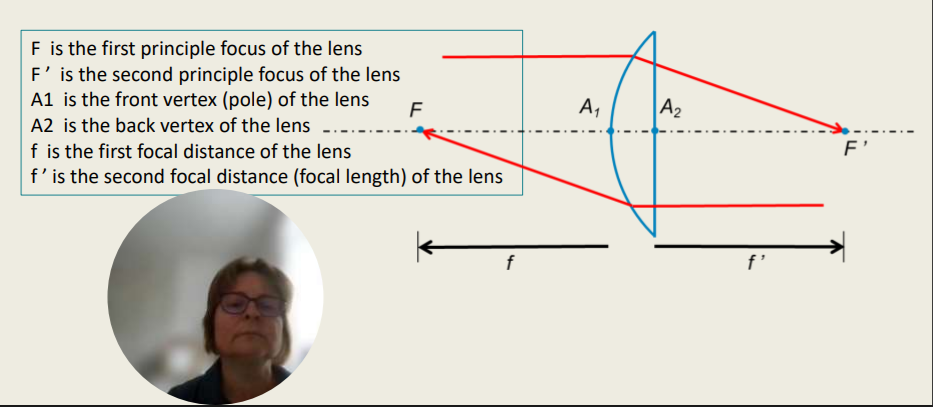
Refraction on Thin Lenses - Terminology
A lens (thin or thick) consists of two refracting surfaces.
The unit of lens power (F) is called the Dioptre.
F is given by the equation: 𝐅=𝐧/𝐟′ with l’=f’ in metres for an incident vergence of 0.
In air this equation can be substituted to 𝐅=𝟏/𝐟′
F is the first principle focus of the lens
F ’ is the second principle focus of the lens
A1 is the front vertex (pole) of the lens
A2 is the back vertex of the lens
f is the first focal distance of the lens
f ’ is the second focal distance (focal length) of the lens
A lens consists of _______ refrcting surfaces.
Two
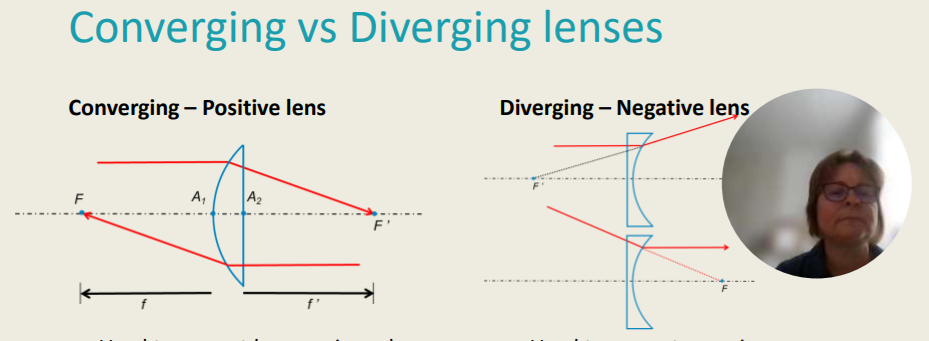
Converging vs Diverging Lenses
Converging Lens (Positive lens)
used to correct hyperopia and presbyopia
Positive Lenses are thickest at the centre and thinnest at the lens edge
Lenses can be: biconvex, plano convex, and convex meniscus
Diverging Lens (Negative Lens)
Used to Correct Myopia
Negative lenses are thickest at the edge and thinnest at the center
Lenses can be: Biconcave, plano concave and concave meniscus
________ lenses are used to correct myopia and ______ lenses are used to correct hyperopia and presbyopia.
Diverging (Negative Lenses); Converging (Positive Lenses)
Specifications in Optometry
In optometry, we normally specify lens power to two decimal places.
Spectacle prescriptions are issued in 0.25 D steps and the sign must be specified (+ or -)
A lens with no focal power is termed a plano lens, which is either written “plano” or “∞”
A ______ lens has no focal power.
Plano
Thin Lenses - Vergence Calculations
A thin lens is one in which the thickness (between both surfaces) is considerable negligible and, so can be ignored.
For a thin lens, the power is equal to the sum of surface powers. 𝑭 = 𝑭𝟏+𝑭𝟐
For a thin lens in air (n=1), the image position can be deduced mathematically using the known vergence equations.
Incident Vergence: 𝑳 = 𝟏 / 𝒍
Emergent Vergence: 𝑳′ = 𝟏 / 𝒍′ and 𝑭 = 𝑳 ′ − 𝑳
Example: Where will the image form if an object is placed 40 cm in front of a thin lens of power +6.00 D?
How I calculated the answer:
Conversion:
40cm to m = -40 × 0.01 = -0.4m
Incidence Vergence:
L = 1 / -0.4 m = -2.50 D
Emergent Vergence:
L' = F + L
L’ = +6.00 D - 2.50 D = +3.50 D
Converting Vergence Into Vergence Distance:
L’ = 1 / i’ → I’ = 1 / L’
I’ = 1 / L’ = I’ = 1 / 3.50 (1/m) = + 0.286m
Answer = 28.6cm

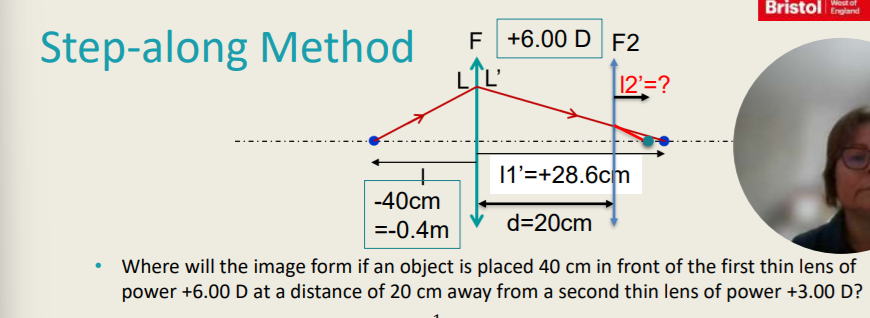
Step-Along Method
Example Question: Where will the image form if an object is placed 40 cm in front of the first thin lens of power +6.00 D at a distance of 20 cm away from a second thin lens of power +3.00 D?
Answer:
L1
Conversion:
40cm to m = -40 × 0.01 = -0.4m
Incidence Vergence:
L1 = 1 / -0.4 m = -2.50 D
Emergent Vergence:
L1' = F + L
L1’ = +6.00 D - 2.50 D = +3.50 D
Transition L1 to L2:
i2 = (L1’- d)
L2 = n / i2 → L2 = 1 / (0.286m-0.20m)
L2 = +11.63D
L2
Emergent Vergence:
L2' = F2 + L2 = +3.00 D + +11.63 D = +14.63 D
Convergent Emergence:
L2’ = 1 / i2’ → i2’ = 1 / L2’
i2’ = 1 / 14.63 (1/m) = +0.0683 m
Final answer = +6.8cm
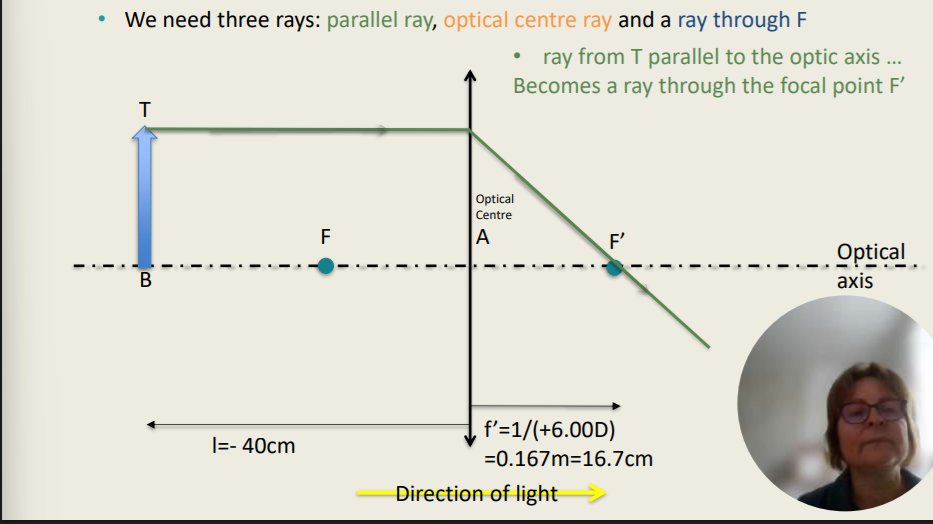
Refraction on Thin Lenses - Graphical RayTracing 1, 2, 3
We need three rays:
Parallel ray (T), optical centre ray (A), and a ray through (F)
A ray from T parallel to the optic axis becomes a ray through the focal point F’
Where will the image form if an object is placed 40 cm in front of a thin lens of power +6.00 D?
How I Calculated the Answer:
F = n / f’ → f’ = n / F
f’ = 1 / (+6.00) = 0.167m
Final answer: 16.7cm
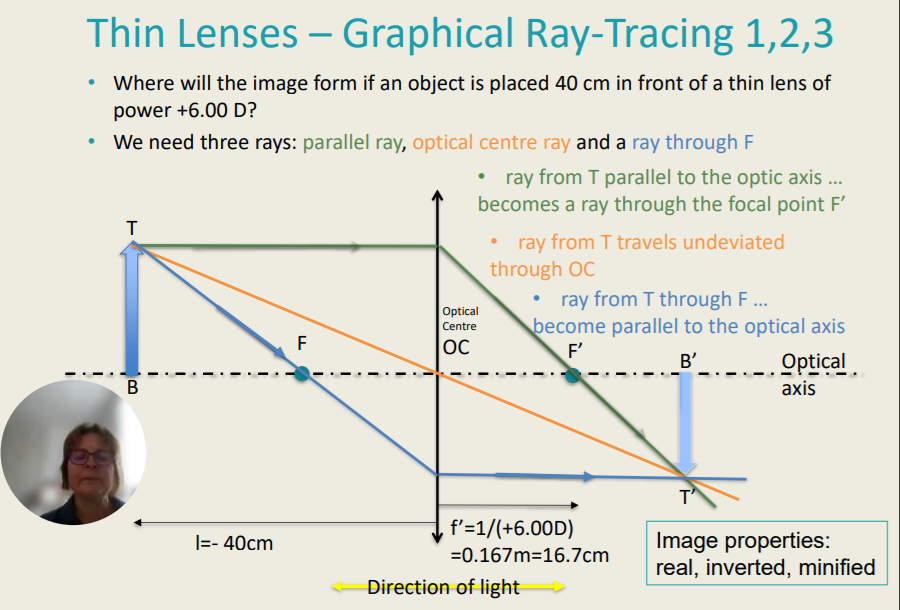
Application in Optometry (One Example)
Binocular Indirect Ophthalmoscopy (BIO):
A head mounted light source is used and a +20 D or + 30 D lens
Distances determine image size and handling comfort
Image will be inverted
These calculations have applications in clinical practice for ________.
Slit Lamp BiO
Calculation for Yourself and Check Answers in the Seminar:
Where will the image form from an object which is placed 40 cm in front of the first surface with a radius of curvature of + 83 mm at a distance of 20 cm away from a second surface with a radius of curvature of -166 mm? the refractive index n between the two surfaces is 1.498
How I calculated this answer:
Method: Step-Along
Surface Power: 𝑭 = (𝒏 ′−𝒏) / 𝒓 (given by radius of curvature) and 𝑭 = 𝑳 ′ − 𝑳 → rearrange for L’ (algebra)
F1 = (𝒏 ′−𝒏) / 𝒓 = (1.498 - 1) / 0.083m = +6.00D
Incident Vergence: 𝑳 = 𝒏 / 𝒍 (given by task)
L1 = n / i1 → 1 / -0.4m = -2.50D
L1’ = F1 + L1 = +6.00D + (-2.50D) = +3.50D
Emergent Vergence: 𝑳′ = 𝒏′ / 𝒍′ (unknown)
L1’ = n’ / i1’
i1’ = n’ / L1’ = 1.498 / +3.50D = +0.428 m
+0.428 m = 42.8cm
i2 = i1’ - d = +0.228m
L1’ serves as object for surface 2 : 𝒍𝟐 = +𝟎.𝟒𝟐𝟖 𝒎 − (+𝟎.𝟐𝟎 𝒎) = +𝟎.𝟐𝟐𝟖m
Incident Vergence 2:
L2 = n’ / i2 = 1.498 / +0.228 = +6.57D = +6.50D
Surface power 2:
𝑭𝟐 = (𝒏′ − 𝒏) / 𝒓𝟐 = 𝟏−𝟏.𝟒𝟗𝟖 / −𝟎.𝟏𝟔𝟔𝒎 = +𝟑.00D
L2 = F2 + L2 = +3.00D + 6.57D = +9.57D
Emergent Vergence
L2’ = n / i2’ → i2’ = n’ / L2’
i2’ = 1 / +9.57D = +0.104m = 10.4cm
Final answer = 10.4cm
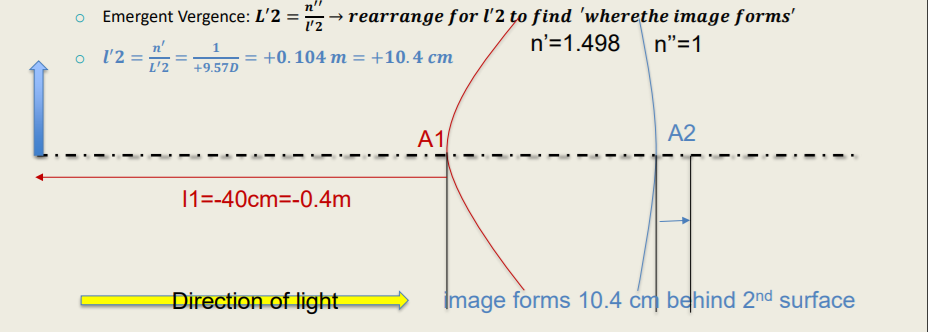

Calculate for yourself and check:
Where will the image form from an object which is placed 40 cm in front of the first surface with a radius of curvature of + 83 mm at a distance of 20 cm away from a second surface with a radius of curvature of -166 mm? Both surfaces are placed in water (n=1.33) and the refractive index n’ between the two surfaces is 1.498
Final answer is 7.52cm. (Come back later to actually work it out as this answer is from chatgpt)
Need to know:
Refraction is the change in direction of a light wave due to a change in its velocity and the refractive index “n” reflects this relationship.
Snell’s Law of refraction (plane surfaces): 𝒏 × 𝒔𝒊𝒏 𝒊 = 𝒏′ × 𝒔𝒊𝒏 𝒊′
Reduced optical thickness: 𝒅 = 𝒕 / 𝒏
Total internal reflection: 𝐬𝐢𝐧 𝒊𝒄 = 𝒏𝒂𝒊𝒓 / 𝒏𝒈𝒍𝒂𝒔𝒔 = 𝒏′ / 𝒏
Refraction on curved surfaces applying vergence equations:
Surface Power: 𝑭 = (𝒏 ′−𝒏) / 𝒓 and 𝑭 = 𝑳 ′ − 𝑳
Incident Vergence: 𝑳 = 𝒏 / 𝒍
Emergent Vergence: 𝑳′ = 𝒏′ / 𝒍′
Parallel rays have a vergence of “0 D”
One application of the knowledge gained today is BIO – binocular indirect ophthalmoscopy
Refraction is the change in direction of a ____ due to a change in its ____ and the ______ “n” reflects this relationship.
Light Wave; Velocity; Refractive Index